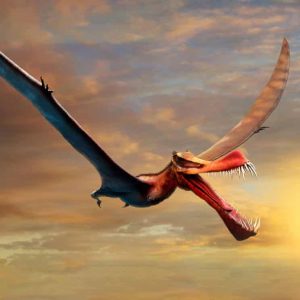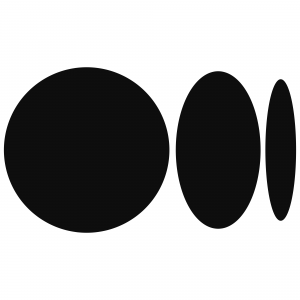Link About It: This Week’s Picks
A dragon-like dinosaur, an illustrated celebration of cities, an Iron Age discovery and more

First-Ever Light Detected Behind a Black Hole
 Most space enthusiasts are aware that nothing can escape the tremendous gravitational pull of a black hole but, for the first time ever, scientists have detected light coming from behind a black hole located 800 million light-years from Earth. While flares of light around a black hole aren’t uncommon, astrophysicist Dan Wilkins and his colleagues had been observing a particular supermassive black hole (using NASA’s NuSTAR and the European Space Agency’s XMM-Newton telescopes) and “noticed smaller flashes of x-rays that occurred later and were different colors”—and they were coming from a different location on the far side of the black hole. “Any light that goes into that black hole doesn’t come out, so we shouldn’t be able to see anything that’s behind the black hole,” says Wilkins. Not only is this a first-ever observation, it also supports a prediction based in Albert Einstein’s theory of general relativity—the idea that our understanding of gravity comes from the curvature of space and time. Read more at CNN.
Most space enthusiasts are aware that nothing can escape the tremendous gravitational pull of a black hole but, for the first time ever, scientists have detected light coming from behind a black hole located 800 million light-years from Earth. While flares of light around a black hole aren’t uncommon, astrophysicist Dan Wilkins and his colleagues had been observing a particular supermassive black hole (using NASA’s NuSTAR and the European Space Agency’s XMM-Newton telescopes) and “noticed smaller flashes of x-rays that occurred later and were different colors”—and they were coming from a different location on the far side of the black hole. “Any light that goes into that black hole doesn’t come out, so we shouldn’t be able to see anything that’s behind the black hole,” says Wilkins. Not only is this a first-ever observation, it also supports a prediction based in Albert Einstein’s theory of general relativity—the idea that our understanding of gravity comes from the curvature of space and time. Read more at CNN.
Image courtesy of NASA
The AI-Regulated Exo-Abs Robotic Device Helps Paralyzed People Breathe
 What began as an exploratory project within the Soft Robotics Research Center lab at Seoul National University, the Exo-Abs robotic device may one day be a commercial support system that helps paralyzed individuals cough, breathe, speak—and even sing. The artificial intelligence-regulated device automatically applies pressure to the abdomen of the person using it, ascertaining their need through sensors. “When you breathe out, you’re basically pushing the belly and narrowing down the volume of the lungs, so we’re trying to mimic that process,” Seoul National University professor Cho Kyu-jin tells Wired. Read more about the technology and what it is capable of doing there.
What began as an exploratory project within the Soft Robotics Research Center lab at Seoul National University, the Exo-Abs robotic device may one day be a commercial support system that helps paralyzed individuals cough, breathe, speak—and even sing. The artificial intelligence-regulated device automatically applies pressure to the abdomen of the person using it, ascertaining their need through sensors. “When you breathe out, you’re basically pushing the belly and narrowing down the volume of the lungs, so we’re trying to mimic that process,” Seoul National University professor Cho Kyu-jin tells Wired. Read more about the technology and what it is capable of doing there.
Image courtesy of Seoul National University
New Dragon-like Species of Dinosaur Discovered in Australia
 The fossil of a massive pterosaur found a decade ago in the Australian outback has been confirmed as a previously unknown species of dinosaur. The creature—with an estimated seven-meter wingspan and “40 razor-sharp teeth”—is being compared to a dragon. To explain the size, Tim Richards (a researcher at the University of Queensland) says to picture a wingspan only slightly smaller than a hang-glider. “It would have been a fearsome sight,” he says. “From its morphology, it’s mostly likely adapted for a carnivorous lifestyle. Its teeth were probably designed more for holding on to slippery fish.” It has been named Thapunngaka shawi, “a combination of the Wanamara nation words for ‘spear’ and ‘mouth,’ and the surname of the person who discovered the fossil.” Believed to have lived 105 million years ago, it’s the biggest flying reptile to have existed on the continent. Read more at The Guardian.
The fossil of a massive pterosaur found a decade ago in the Australian outback has been confirmed as a previously unknown species of dinosaur. The creature—with an estimated seven-meter wingspan and “40 razor-sharp teeth”—is being compared to a dragon. To explain the size, Tim Richards (a researcher at the University of Queensland) says to picture a wingspan only slightly smaller than a hang-glider. “It would have been a fearsome sight,” he says. “From its morphology, it’s mostly likely adapted for a carnivorous lifestyle. Its teeth were probably designed more for holding on to slippery fish.” It has been named Thapunngaka shawi, “a combination of the Wanamara nation words for ‘spear’ and ‘mouth,’ and the surname of the person who discovered the fossil.” Believed to have lived 105 million years ago, it’s the biggest flying reptile to have existed on the continent. Read more at The Guardian.
Image courtesy of University of Queensland
Finland’s Nonbinary Iron Age Warrior
 Discovered at Finland’s Suontaka Vesitorninmäki in 1968, an Iron Age grave held the mysterious remains of a celebrated warrior whose gender puzzled scientists for decades, as the deceased was accompanied by weapons associated with men of the era and jewelry associated with women from the time period. Now, new information released by geneticist Elina Salmela of the University of Helsinki reveals that the figure was likely (with 99.75% certainty) a nonbinary person with an extra X chromosome—creating the sex-chromosomal aneuploidy XXY, otherwise known as Klinefelter syndrome. Read more about the scientific testing, the artifacts that were found with the body and what it all means, at Artnet.
Discovered at Finland’s Suontaka Vesitorninmäki in 1968, an Iron Age grave held the mysterious remains of a celebrated warrior whose gender puzzled scientists for decades, as the deceased was accompanied by weapons associated with men of the era and jewelry associated with women from the time period. Now, new information released by geneticist Elina Salmela of the University of Helsinki reveals that the figure was likely (with 99.75% certainty) a nonbinary person with an extra X chromosome—creating the sex-chromosomal aneuploidy XXY, otherwise known as Klinefelter syndrome. Read more about the scientific testing, the artifacts that were found with the body and what it all means, at Artnet.
Image courtesy of Veronika Paschenko
Medium To Offer Writers 50% of Subscriber Revenue Their Content Generates
 In comparison to other digital media platforms, Medium was quick to compensate creators—and, according to Digiday, “Medium’s Partner Program has attracted more than 200,000 enrollees and paid out some $28 million to participants since the program’s launch in 2017.” That said, Medium will further their partner program with a new initiative that compensates writers with 50% of the new subscriber revenue their content generates (after payment processing fees). It’s one of many thoughtful changes the site will introduce to their creator economy, which intends to attract subscribers as well as writers. Read more about the developments at Digiday.
In comparison to other digital media platforms, Medium was quick to compensate creators—and, according to Digiday, “Medium’s Partner Program has attracted more than 200,000 enrollees and paid out some $28 million to participants since the program’s launch in 2017.” That said, Medium will further their partner program with a new initiative that compensates writers with 50% of the new subscriber revenue their content generates (after payment processing fees). It’s one of many thoughtful changes the site will introduce to their creator economy, which intends to attract subscribers as well as writers. Read more about the developments at Digiday.
Image courtesy of Medium
Illustrator Carlo Stanga’s Vibrant Visual Essays with Moleskine
 Italian illustrator Carlo Stanga has partnered with Moleskine on three storybooks (and a limited edition notebook series), each of which is dedicated to either NYC, London or Milan. Within this “I Am The City” series, Stanga brings these international capital cities to life through compelling artistic takes on their landmarks and inhabitants in his vibrant signature style. “Cities are similar to people in that they are unique with lots of character, history and charm,” Stanga tells Surface. Read more about his creative process, and the collaboration, at Surface.
Italian illustrator Carlo Stanga has partnered with Moleskine on three storybooks (and a limited edition notebook series), each of which is dedicated to either NYC, London or Milan. Within this “I Am The City” series, Stanga brings these international capital cities to life through compelling artistic takes on their landmarks and inhabitants in his vibrant signature style. “Cities are similar to people in that they are unique with lots of character, history and charm,” Stanga tells Surface. Read more about his creative process, and the collaboration, at Surface.
Image courtesy of Carlo Stanga and Moleskine
Link About It is our filtered look at the web, shared daily in Link and on social media, and rounded up every Saturday morning. Hero image courtesy of Carlo Stanga and Moleskine












